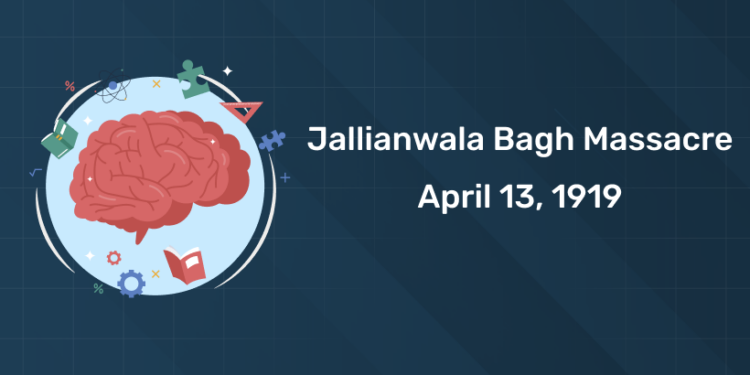Table of Contents
“Thousands died for the freedom of billions.” 100 years passed, still the city hurts with the memories of blood stains and screams of innocent souls. Thousands of people were injured, hundreds of deaths from innocent children to respected elderly citizens. April 13, 1919 a day when hundreds sacrificed their lives without knowing why. A massacre for which we still did not get answer to. The Jallianwala Bagh massacre, the day of end of humanity, the day that can never be forgotten in the history of India. On the thirteenth of the month of April let us spend a minute remembering the innocent souls who were perished by the cruelty of mankind. In this article let us check the cause and impact of Jallianwala Bagh Massacre.
Jallianwala Bagh massacre – Cause and Impact
In this article we will give the reader a glimpse on series of events related to this massacre. The discussion topics are mentioned below
- What led to the drastic massacre?
- Rowlatt Act
- Jallianwala Bagh Massacre, April 13, 1919
- Hunter commission
- Response by nationalists
- Jallianwala Bagh Centenary Commemoration Committee (JBCCC)
- General Knowledge questions with answers on Jallianwala Bagh Massacre
What Led to the Drastic Massacre?
During the World War 1 (1914-1918) British India contributed to the British war effortlessly by providing resources and men. Millions of Indian Soldiers served in Europe, Africa and the Middle East. By this India expected in return to receive more political autonomy and ease. As many Indians had fought with the British during the First World War they expected much greater expectations after the war. The Montagu-Chelmsford Report presented to the British parliament in 1918 recommended only limited local self-government. Following this the Rowlatt act was passed in 1919 which extended the repressive wartime measures.
This act was responded by anger and discontent by the Indians. A One day general strike also was called in the month of April by Gandhi in response to this act. Many prominent leaders were arrested as a part of the rules set in the Rowlatt act. This angered the people in Amritsar which lead to violent protests on April 10, 1919.
Rowlatt Act
Few rules and regulations set by Rowlatt Act and its significance are given below.
- The Rowlatt act was officially known as the Anarchial and Revolutionary Crimes Act, 1919.
- It was passed in March 1919 by the Imperial Legislative council
- This act was passed as per the recommendations of the Rowlatt committee which was chaired by Judge, Sir Sidney Rowlatt.
- This act authorised the British government to arrest anyone who was suspected of terrorist activities
- The British was also authorised to detain the arrested people up to 2 years without trial.
- It placed severe restrictions on the freedom of press
- It also empowered the police to search for a place without a warrant.
- This act was condemned by the Indian leaders and public
- The bills was known as Black Bills
- The British governments primary intention was to repress the growing nationalist movement in the country
Jallianwala Bagh Massacre
- The protests continued to grow by the Indian leaders and public in response to the Rowlatt act passed
- On April 9, 1919 two nationalist leaders Saifuddin Kitchlew and Dr. Satyapal was arrested by the British officials because they had addressed the protests meetings.
- This led to the calling of a strike on April 10, 1919 by Gandhi to show their solidarity with the leaders who were arrested
- Soon protests in Punjab started turning violent. Brigadier- General Dyer was given handed over the responsibility to curb the protests and to enforce the law and order at Amritsar, Punjab.
- On April 13, 1919 the day of festival of Baisakhi in Jallianwala Bagh, A group of people had gathered. The crowd had nonviolent protestors and few of them were pilgrims who had come to celebrate the festival.
- Earlier on April 13 General Dyer had asked to ban all meetings but the notice was not widely disseminated. Unaware of this the villagers had gathered to celebrate the festival at the garden.
- General Dyer and troops entered the garden by blocking the main entrance and with no warning he and his team opened fire on the crowd for about ten minutes.
- Bullets were targeted towards the few gates that were open killing the unarmed people who were trying to flee.
- The firing killed 400 people including men, women and children. Over thousands were injured in this brutal incident.
- Jallianwala Bagh massacre is also known as Amritsar Massacre
Hunter commission
- Hunters commission is a committee formed by the government on India on October 14, 1919 to inquire the events at Punjab
- It was named after the chairman William, Lord Hunter
- The purpose of the commission was to investigate the disturbances in Punjab, find the cause and bring measures to cope with the effects
- According to the report submitted by the commission the action of General dyer was strongly condemned
- No disciplinary action was taken against Dyer’s act
- However he was finally found guilty and relieved of his command on March 23.
- He was removed from his appointment and was prohibited from further employment in India
Response by Indian nationalists
- Rabindranath Tagore renounced his knighthood in protest.
- Mahatma Gandhi gave up the title of Kaiser-i-Hind, bestowed by the British for his work during the Boer War.
Jallianwala Bagh Centenary Commemoration Committee (JBCCC)
The JBCCC was set up to commemorate the 100th anniversary, hold a debate, and host an event at the House of Lords and to organize exhibitions in London, Birmingham and Manchester. The goal is to raise awareness of this unfortunate event and to request an apology from the British government.
Last year 2019, marked the 100th year of the brutal incident. JBCCC organized many exhibitions even at Amritsar to pay tribute and hour to the thousands of innocent people who lost their lives.
Jallianwala Bagh Massacre Day 2025: Remembering the Day Humanity Failed
1: Who was the first woman President of India?
“Thousands died for the freedom of billions.”
Over 100 years have passed, yet the pain of April 13, 1919, still echoes in the streets of Amritsar. Innocent children, women, and elderly citizens were killed mercilessly. Blood flowed where joy once lived, on the sacred day of Baisakhi. The Jallianwala Bagh massacre was not just an act of violence, but a mark of cruelty etched forever in India’s soul. In this article, let us explore the causes, consequences, and commemorations of this dark chapter in Indian history.
Free UPSKILLING Courses!
Take your first step toward mastering in-demand skills, acing interviews, and securing top-tier jobs with Entri's free upskilling courses.
Start Learning!Jallianwala Bagh Massacre Day 2025 Theme
Each year, Jallianwala Bagh Massacre Day is observed with a theme to guide discussions and memorial events. The theme for 2025 is:
“From Remembrance to Resistance: Honoring the Past, Empowering the Future.”
This theme encourages not only remembrance of the tragedy but also reflection on how historical injustices shape modern democratic values and human rights activism.
Previous Year Themes
Here are the themes from recent years:
-
2024: “Echoes of April 13: Remember, Reflect, Reclaim.”
-
2023: “Justice Delayed, Memory Eternal.”
-
2022: “Saluting the Martyrs of Jallianwala: A Century of Courage.”
-
2019 (Centenary Year): “100 Years On: Remembering the Massacre, Demanding Apology.”
These themes highlight the continued relevance of the massacre and its lessons for future generations.
How is Jallianwala Bagh Massacre Day Observed?
Every year on April 13, the nation pauses to honor the martyrs. Here’s how the day is marked:
-
Floral tributes and silent prayers are held at the Jallianwala Bagh memorial in Amritsar.
-
Schools and institutions conduct debates, exhibitions, and essay competitions on colonial injustice and freedom struggles.
-
The Prime Minister and President of India often issue messages remembering the victims.
-
Documentaries and discussions are broadcast on national TV channels.
-
Diaspora communities and organizations like JBCCC hold commemorative events in UK, Canada, and the US, urging for a formal apology from Britain.
-
Civil society groups organize peace walks and human rights seminars, reflecting on the values of liberty and non-violence.
Subscribe Entri for more topics in general Knowledge
Free UPSKILLING Courses!
Take your first step toward mastering in-demand skills, acing interviews, and securing top-tier jobs with Entri's free upskilling courses.
Start Learning!Jallianwala Bagh Massacre Quiz – General Knowledge Questions with Answers
Please find the below GK questions that you need to prepare with for the Static GK sector of any competitive examination. The answers are highlighted.
A) P. Ramaswami Iyer
B) Muhammad Ali Jinnah
C) N. Sarma
D) Shankaran Nair
3. Who was the Viceroy of India at the time of Jallianwala Bagh Massacre?
A) Shankaran Nair
B) Rabindranath Tagore
C) Mahatma Gandhi
5. Which one of the following commissions/committees was appointed by the British Government to investigate into the massacre in Jallianwala Bagh?
Conclusion
The Jallianwala Bagh massacre was not just an isolated incident—it was a turning point in India’s freedom struggle. It exposed the brutal face of colonial rule and sparked a nationwide awakening. As we observe Jallianwala Bagh Massacre Day 2025, let us remember the countless lives lost, reflect on the lessons of history, and commit ourselves to peace, justice, and democracy. Let their sacrifice be our strength to stand against oppression, now and forever.
Let us not forget—April 13 must always be remembered.
Free UPSKILLING Courses!
Take your first step toward mastering in-demand skills, acing interviews, and securing top-tier jobs with Entri's free upskilling courses.
Start Learning!Frequently Asked Questions
What is Jallianwala Bagh Massacre Day?
It marks the anniversary of the tragic massacre in Amritsar on April 13, 1919. British troops opened fire on peaceful civilians gathered at Jallianwala Bagh. The day is observed to remember the victims and reflect on colonial injustices.
Why did the Jallianwala Bagh massacre happen?
It followed widespread protests against the Rowlatt Act of 1919. British authorities feared unrest and responded with violence. The gathering included many unaware of the protest ban.
Who was responsible for the Jallianwala Bagh massacre?
Brigadier-General Reginald Dyer ordered the open fire without warning. His actions were later condemned but not criminally punished. He was relieved from further duties in India.
What was the Rowlatt Act?
It allowed the British to detain Indians without trial. It also restricted press freedom and increased police powers. This triggered national protests and resistance movements.
How is Jallianwala Bagh Massacre Day observed today?
Tributes are paid at memorial sites across India, especially in Amritsar. Public talks, school events, and media tributes remember the victims. Citizens observe a moment of silence in their memory.











